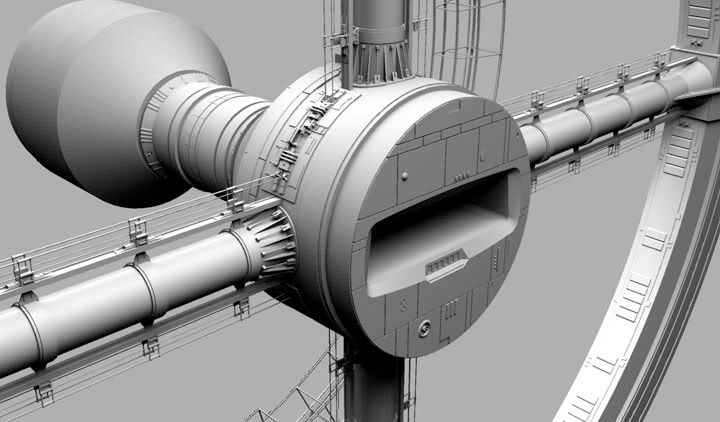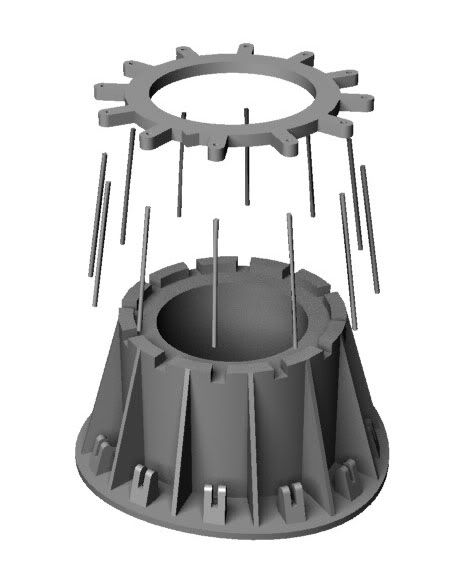Ever since I first saw 2001: A Space Odyssey in 1968 at the age of ten I've wanted to recreate the iconic Space Station V from the film. Nothing else seems to express such joy, optimism and grandeur of the future. Sadly, the year 2001 has come and gone and commercial travel into space is still a ways off, as is such a space station. But we have the technology to create the next best thing here on earth.
So I am undertaking the contruction of a model. As much as I would like to recreate a 'studio scale' replica, the original was 7 to 8 feet in diameter, and I just don't have the room! The planned model size is around 30 inches in diameter. That's plenty big to allow for interior lighting. As the the actual scale, that's a bit of a problem to work out. If you assume the Orion Space Plane is between 165 and 200 feet long (commonly accepted sizes) and that it needs to fit inside the docking bay in the hub of the space station, then the station winds up btween 1500 and 1850 feet in diameter. But at this size, the windows in the ring are between 8 and 9 feet tall. On the interior set the windows look to be about 4 feet tall, which would make the station only 794 feet in diameter, which is too small. So like many movie models, we have to accept that it was built and shot to look good, rather than accurate!
Unfortunately, Kubrik had all the original models and blueprints detroyed so the only thing to use as build reference is the film itself, Robert McCall's poster art (the poster was obviously painted using the model as a reference and there are a few details decernable from the poster that cannot be clearly seen in the film) and the photos of the remains of the studio scale model taken in the 70's.
For those of you that are interested, I WILL be producing this model as a kit! It's gonna take a while so you'll have to be patient. No ETAs or price estimates.
I started by selecting a few key HD frame grabs from the BluRay disc of the film, then drawing over them in VectorWorks, a CAD program. A bit of back and forth between drawings and I had some basic proportions. The drawings were then imported into SktechUp where a quick 3D model was mocked up. This allowed me to look at the station from various angles to see if overall it looks correct. Here are a couple of early renderings of the SketchUp model, not alot of details yet.


From SketchUp I move to Rhino, a 3D solid modelling program that can be used to create 3D stereo lithography master parts as well as laser cut and photo-etched parts. Here's a view of some of the details on the Rhino model.

Lots of back and forth refering to various frame grabs from the movie and the details are evolving.

As a test, I had the ribbed connector that goes at the base of the spokes 3D printed using stereo lthography. Here's a view of the Rhino file, exploded into it's component parts.

And here's the SLA output part, the spoked ring snaps into the crenelated top of the base. The part is a little larger than a quarter across at the top and 3/4" tall.

So I am undertaking the contruction of a model. As much as I would like to recreate a 'studio scale' replica, the original was 7 to 8 feet in diameter, and I just don't have the room! The planned model size is around 30 inches in diameter. That's plenty big to allow for interior lighting. As the the actual scale, that's a bit of a problem to work out. If you assume the Orion Space Plane is between 165 and 200 feet long (commonly accepted sizes) and that it needs to fit inside the docking bay in the hub of the space station, then the station winds up btween 1500 and 1850 feet in diameter. But at this size, the windows in the ring are between 8 and 9 feet tall. On the interior set the windows look to be about 4 feet tall, which would make the station only 794 feet in diameter, which is too small. So like many movie models, we have to accept that it was built and shot to look good, rather than accurate!
Unfortunately, Kubrik had all the original models and blueprints detroyed so the only thing to use as build reference is the film itself, Robert McCall's poster art (the poster was obviously painted using the model as a reference and there are a few details decernable from the poster that cannot be clearly seen in the film) and the photos of the remains of the studio scale model taken in the 70's.
For those of you that are interested, I WILL be producing this model as a kit! It's gonna take a while so you'll have to be patient. No ETAs or price estimates.
I started by selecting a few key HD frame grabs from the BluRay disc of the film, then drawing over them in VectorWorks, a CAD program. A bit of back and forth between drawings and I had some basic proportions. The drawings were then imported into SktechUp where a quick 3D model was mocked up. This allowed me to look at the station from various angles to see if overall it looks correct. Here are a couple of early renderings of the SketchUp model, not alot of details yet.


From SketchUp I move to Rhino, a 3D solid modelling program that can be used to create 3D stereo lithography master parts as well as laser cut and photo-etched parts. Here's a view of some of the details on the Rhino model.

Lots of back and forth refering to various frame grabs from the movie and the details are evolving.

As a test, I had the ribbed connector that goes at the base of the spokes 3D printed using stereo lthography. Here's a view of the Rhino file, exploded into it's component parts.

And here's the SLA output part, the spoked ring snaps into the crenelated top of the base. The part is a little larger than a quarter across at the top and 3/4" tall.





